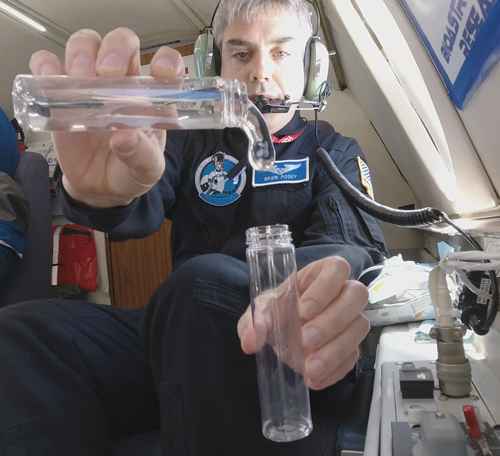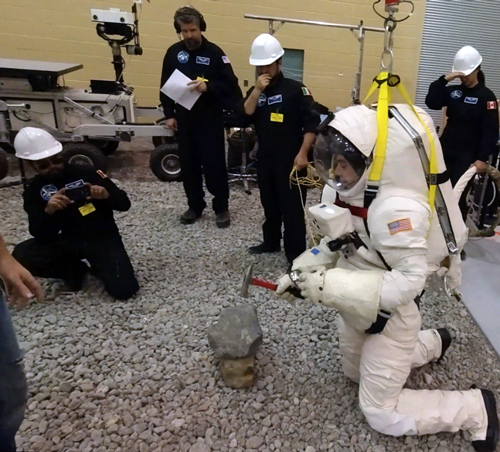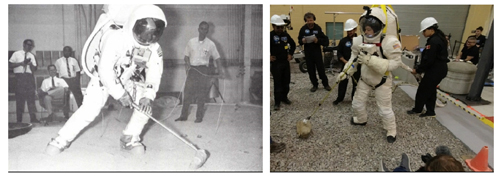Posey's Moonshot
What It's Like To Work on the Moon (Without Actually Going to the Moon)
Brien's lunar training often puts him in situations where gravity, as we Earthlings know it, doesn't exist.
Because this column is called Posey's Moonshot, I thought it might be fitting to talk about what it's like to work on the moon. Now, obviously, I have never been to the moon. The last Apollo mission took place before I was even born. Likewise, nobody has told me to pack my bags because I am going to the moon.
Even so, a lot of the training that I did last year placed a considerable emphasis on lunar missions, and it seems that there will be additional lunar training over the next few months.
So with all that said, let's get back to the question at hand: What is it like to work on the moon?
Inside the 'Vomit Comet'
One of the things that makes the moon such a unique environment is that the moon's gravity is one-sixth that of the Earth's. To put this into prospective, I currently weigh 155 pounds. That means that my weight on the moon would be less than 26 pounds (although in real life, you would also have to consider the weight of the spacesuit).
One of the best parts about training to go to space is that you get to spend a lot of time working in zero gravity. The only way to experience true zero gravity without actually going to space is onboard an airplane that is affectionately known as the "vomit comet." The airplane flies in a series of parabolic arcs and provides 20 to 30 seconds of weightlessness during the descent portion of each parabola.
However, the vomit comet can do more than just create zero gravity conditions. It can also create lunar gravity. The pilot simply slows the descent rate to the point that the effective gravity onboard the jet is the same as what you would experience on the moon.
Lunar gravity is a strange sensation. In fact, it really messes with my mind every time that I experience it. It feels almost exactly like zero gravity, but nothing floats. Each time that I have experienced lunar gravity, I have felt really disoriented. It almost feels like gravity isn't working the way that it's supposed to. During the parabola, my mind is telling me that I am weightless, and yet my eyes tell me the opposite.
Despite lunar gravity feeling a bit odd, working in lunar gravity is an interesting experience. The first time I was in lunar gravity, I was instructed to try doing some pushups. On the first try, I pushed way too hard and ended up going airborne. In fact, I didn't just go a little bit airborne -- my back slammed into the airplane's ceiling.
I soon figured out that the low-gravity environment made it possible to go from a pushup position to a standing position with a single push. I didn't think to try it myself, but some of the people on the flight with me found that they were able to do pushups using a single finger.
More recently, I had the opportunity to do some experiments to see how water behaves in lunar gravity. To say that water behaves strangely in one-sixth gravity would be an understatement. When you attempt to pour water, you have to use a small amount of force to start the flow. Presumably, this is because the water's surface tension is stronger than the gravity.
Once the water starts flowing, it initially forms a glob at the edge of the container. When the glob becomes heavy enough, it falls from the container, pulling the rest of the water out with it. The water's behavior is a little difficult to describe, but you can see what it looks like in Figure 1.
 [Click on image for larger view.] Figure 1: This is what happens when you pour water in lunar gravity.
[Click on image for larger view.] Figure 1: This is what happens when you pour water in lunar gravity.
Simulating a Spacewalk
Not all of my lunar training has been on board the vomit comet. Roughly a year ago, I went through a training program to learn lunar and Martian geology. That training program involved a few months of academic training, followed by a week in the Arizona desert learning how to apply what I had learned in the classroom.
As cool as that experience might have been, though, I was later given the opportunity to use those same techniques while wearing an EVA spacesuit in one-sixth gravity conditions. This time, however, I wasn't flying onboard the vomit comet. Instead, the spacesuit was attached to a gravity offset device that could emulate one-sixth gravity.
Prior to using a spacesuit in one-sixth gravity, I tried out the gravity offset device without the suit so that I could have an idea of what to expect. Without the suit, the gravity offset device was really unimpressive. I felt as though I were jumping on a trampoline or bouncing beneath a bungee cord. Once I had the spacesuit on, using the gravity offset device was a completely different experience. The EVA suit has a hard shell, so I couldn't feel the gravity offset harness like I could when I used it without the suit. I legitimately felt as though I was working in a one-sixth gravity environment (which is good, because that suit is really heavy in Earth's gravity).
Before getting to work, the instructors gave me a few minutes to acclimate to this new environment. I found walking to be at least somewhat challenging. The area where I was working was covered in gravel and the low-gravity environment made it a little tough to get traction on the gravel. I found that it was a lot easier to jump and bounce than to walk normally. I also discovered that wearing an EVA suit and bouncing around on a simulated lunar surface was ridiculously fun. I also found it amusing that the video of my "moon walk" looked a lot like the footage of the Apollo astronauts bouncing around on the moon.
Just as walking in one-sixth gravity was challenging, so too was doing field geology. However, that usually had more to do with the spacesuit than the reduced gravity. The EVA suit has a very limited field of view. Much of the time, I couldn't see what I was doing. Thankfully, the suit has a mirror attached to the wrist, and I was able to use the mirror to compensate for the limited visibility.
The spacesuit's gloves, which are really thick, also made working in the simulated lunar environment challenging. Working against the gloves causes your hands to become tired. More importantly, the gloves can make it difficult to tell how tightly you are gripping an object. I didn't realize that my grip (or lack thereof) was even an issue until a rather unfortunate incident with a hammer.
One of the tasks that I was asked to perform while wearing the EVA suit was to use a rock hammer to break a sample off a small boulder, as shown in Figure 2. When I swung the hammer, I quickly discovered that I did not have as tight a grip on it as I thought that I did. The hammer went sailing out of my hand. At the time, I was surrounded by instructors and other trainees who were scrutinizing my every move, so let's just say that my hammer throw did not go unnoticed. It was a little bit embarrassing, for sure, but thankfully nobody got hurt.
 [Click on image for larger view.] Figure 2: This picture was taken seconds before the infamous hammer incident.
[Click on image for larger view.] Figure 2: This picture was taken seconds before the infamous hammer incident.
As incredible as it was to be doing field geology in an EVA suit on a simulated lunar surface, I really didn't appreciate the similarities to the Apollo program until several weeks later. A friend sent me the picture that is shown in Figure 3.
 [Click on image for larger view.] Figure 3: I was amazed by the similarities between the two photos.
[Click on image for larger view.] Figure 3: I was amazed by the similarities between the two photos.
The picture on the left is an old NASA photo of one of the Apollo astronauts training for a trip to the moon (unfortunately, I can't give proper credit for the picture because I don't know where it came from). The picture on the right is me in an EVA suit, using a very similar tool, performing the same test as the Apollo astronaut in the photo from so long ago.
I honestly have no idea if I will ever have the opportunity to go to the moon. Regardless, I am extremely grateful to those who have given me the chance to find out first hand what it is like to work there.
About the Author
Brien Posey is a 22-time Microsoft MVP with decades of IT experience. As a freelance writer, Posey has written thousands of articles and contributed to several dozen books on a wide variety of IT topics. Prior to going freelance, Posey was a CIO for a national chain of hospitals and health care facilities. He has also served as a network administrator for some of the country's largest insurance companies and for the Department of Defense at Fort Knox. In addition to his continued work in IT, Posey has spent the last several years actively training as a commercial scientist-astronaut candidate in preparation to fly on a mission to study polar mesospheric clouds from space. You can follow his spaceflight training on his Web site.